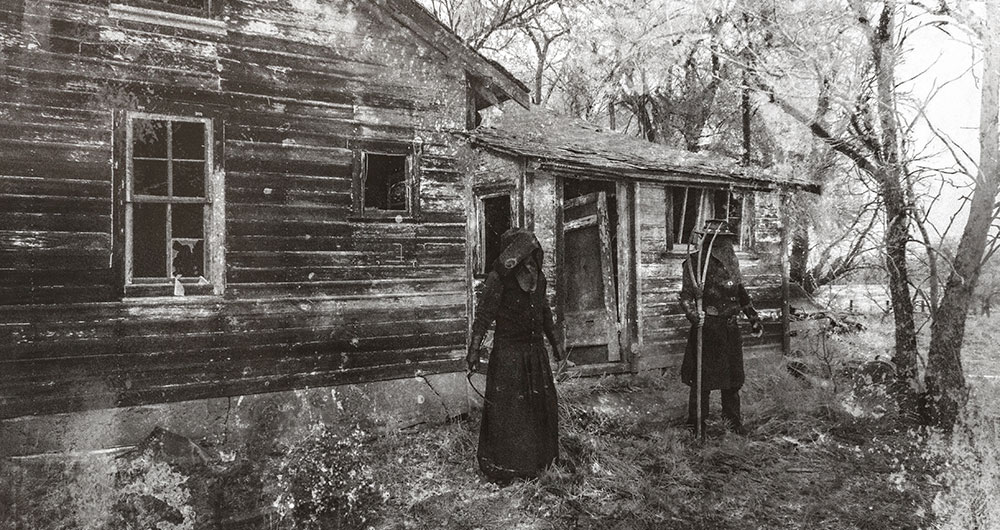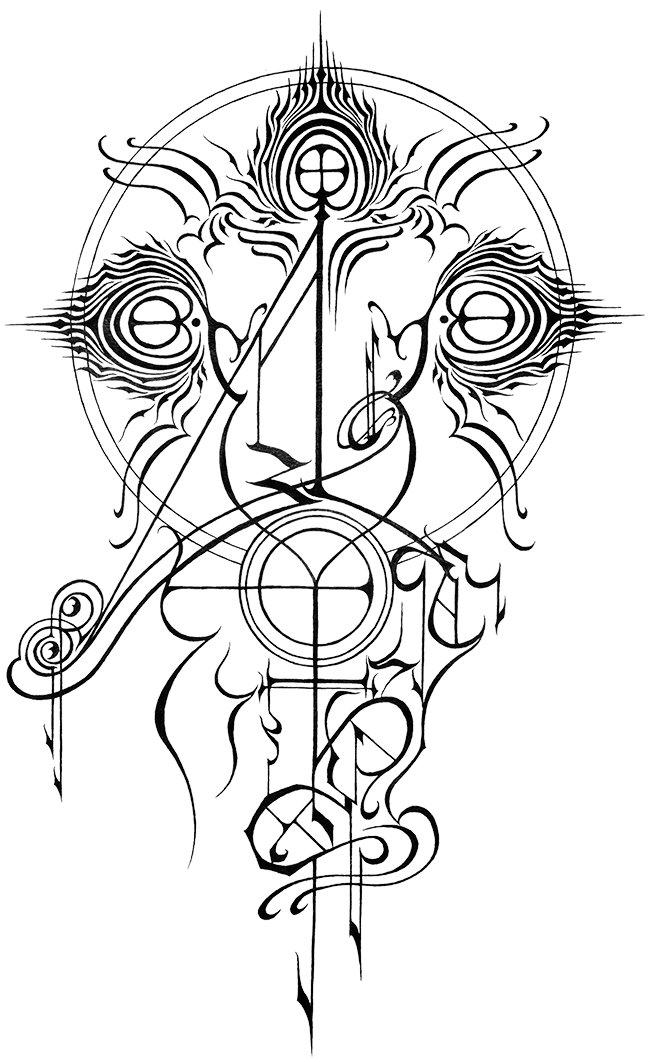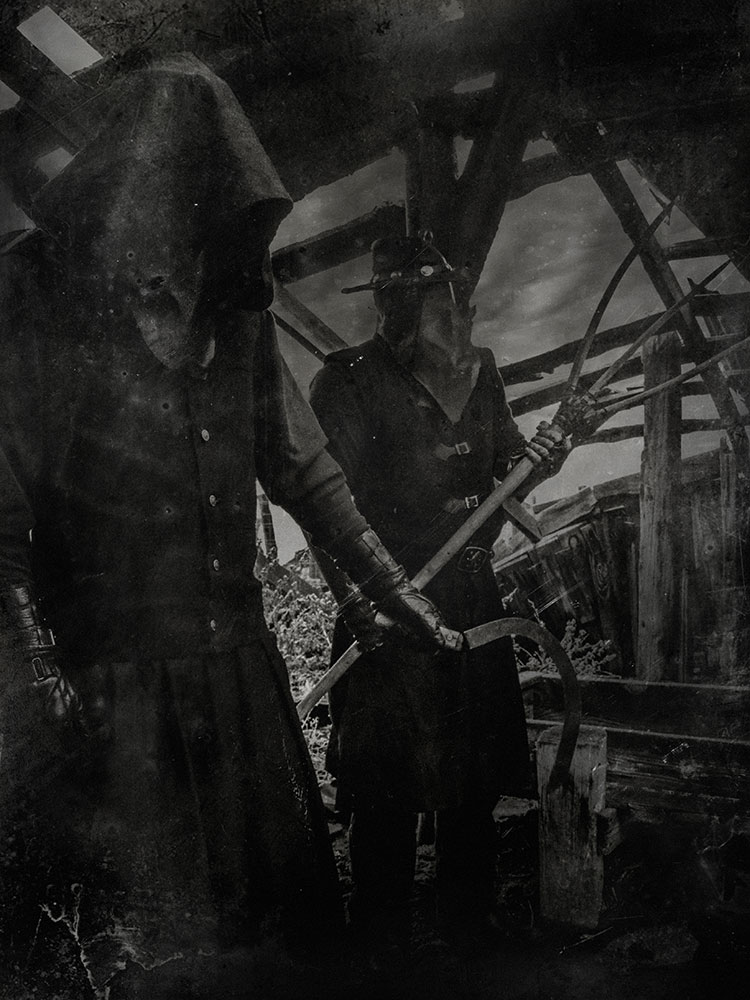Aoratos
2019-10-09
by Niklas Göransson
Ghostly music for abandoned haunts – Naas Alcameth, the creative force behind North American black metal band Aoratos, speaks of ekstasis through fear and trepidation, as well as the terror that comes in the night.
– AORATOS grew out of this idea for a concept I had some years back, one that was initially more of an interesting thought than something actively pursued. At some point I started evaluating my various bands and studio projects and realised I was no longer content with how things were. It was becoming increasingly difficult to accommodate live appearances with NIGHTBRINGER due to the logistical challenges of having members in different countries, as well as several behind-the-scenes factors which made the future of AKHLYS seem uncertain. I also simply missed various band elements such as having a fully localised line-up, playing guitar live, and rehearsing weekly. I’ve spent so much of my musical career doing everything in studio surroundings, with any attempts at live performances being more of an afterthought which would inevitably require a lot of scrambling to pull off. My goal was to at least work towards these things which are now becoming realised.
I read that the album was produced by the same person you’ve used for various projects for the past twenty years now?
– Yes, “Gods Without Name” was produced by Dave Otero at Flatline Audio. Having worked almost exclusively with Dave for two decades now, he has an intimate understanding of the vision and sound I’ve been chasing all these years; each album feels like it moves closer to capturing this. Of course, what I’m looking for is a perpetually elusive thing and I honestly couldn’t say if it can even be fully realised – but the closer the proximity to my vision, the more potent the end result will be in so far as intent.

Upon inspecting “Gods Without Name” I took special notice of the promo photos, which remind me of a blend between American Gothic and the old HBO series Carnivàle.
– That’s an interesting comparison, one I’d not thought about myself but it’s definitely close to the mark since I was a big Carnivàle fan. The photos and overall aesthetics were approached very intentionally with an American Gothic vibe in mind. There were a few factors influencing this really; the album focuses mainly on esoteric folk traditions that are a bit more immediate than some of the grander metaphysical concepts. Immediate yet peripheral, you could say, being relegated to a location’s power, or ‘hauntings’ – certain intelligences associated with specific locations and all that entails. So, given how the subject matter largely revolves around the concept of the genius loci in their darker aspects, I couldn’t help but draw upon areas I’ve gravitated towards or that left certain mental impressions from experiences I’ve had which were, subtle or otherwise, strongly indicative of this phenomenon.
In my understanding, AORATOS’ use of genius loci is in the more traditional sense – meaning, actual autonomous energies or other ethereal presences – rather than more contemporary associations such as the perceived mood or feel of a room.
– Correct. We’re not using this term contemporarily or metaphorically, nor relegating anything to the limitations of psychology. We use it in its original context – as presiding intelligences, spirits, daemons, what have you associated with specific locations and that are, more so within their darker aspect, often linked to experiences of dread and abjection. Of course, the perceived mood of the location is important here, so this is not entirely untrue, but there’s far more to it than that. It’s not uncommon to find others who can relate to such experiences, at least to some degree, regardless if they put stock into the spiritual conceptions; whether it be while hiking in nature and suddenly coming upon a grove that gives them immediate pause for a reason they can’t quite put their finger on, or catching a glimpse past the old cellar door and feeling an unsettling tension. Scattered throughout the plains and Rocky Mountains there are many old abandoned farms, cabins, and ghost towns from the pioneer and gold-rush eras, to which I have been drawn as far back as I can recall. I’ve spent a great deal of time visiting these locations and some of them definitely resonate with an atmosphere that signifies the presence of genius loci.
Naas explains that these locations tend to lie on the thresholds of the world of man and its peripheries; an inhospitable acreage of woods, the abandoned house, old ruins, a basement, the attic, and so on.
– Such locations are always liminal and have this haunting and foreboding vibe arising out of a sense of alienation from the rest of the world. These can become places ’away, above, below, and outside’ the mundane locations of regular habitation and are tantamount to symbolism such as the desert which, in traditional religions, is the place of outcasts and demons. We are naturally apprehensive to enter such areas and, of course, in examples such as nature, one could argue this to be based on instinctual self-preservation against potential physical harm, such as wild animals. Yet there’s another sort of fear or, more specifically, dread that has a markedly different characteristic altogether; one which doesn’t stem from the fear of injury but the terror of something in complete opposition to all we know as rational and ‘of this world’. Here we speak of a dread born from emanations of ‘the Other’. There’s certainly a psychological component at play here as well, I don’t deny that, but it’s only one piece of a much greater picture. A catalyst on the subconscious level that’s also a pathway which, when taken – intentionally or not – can lead into more subtle realities resulting in a metaphysical encounter or experience, for better or for worse. For more on the subject of dread in the metaphysical experience I would refer any readers to the esoteric works of my friend, Richard Gavin.

Are there any known historical genius loci you find particularly interesting?
– There are many of course, especially in places such as Rome, but they are more often connected to sites of heroes, temples, sacred wells, or groves. Although these are certainly fascinating in their own right, I’m more interested in the anonymous and nameless genius loci you stumble upon in forgotten places – ones personally experienced versus born of or popularised by mythology and folktale. Not to say such popularised spirits lack legitimacy, seeing as how many of these stories unquestionably arose from people’s own experiences, more that my fascination is with personal encounters and the value I find within them. Memories of my aunt and uncle’s farm come to mind.
He adds that, like most farmsteads in the region, it was situated in a wide open and sparsely populated area. Many of its structures were very old and some dilapidated.
– There’s something about old barns, grain silos, water wells, or abandoned farmhouses that can radiate an atmosphere that’s both fascinating and repelling, even in the same instance. Not only is there deep symbolism at work within the aesthetic of such places but they can often serve as a warped window into times gone by, the past inextricably linked with the dead. Furthermore, the very fact that they are abandoned, left to their own accord in decay and slow release back to nature, means they become shells of sort; places of vacancy which, through the very absence itself, are a stark contrast to what we know in normal day-to-day life.
Naas says that the more potent this contrast and atmosphere, the stronger one might experience an inexplicable feeling of ’presence’ – an alien pointedness and intellect which defies description.
– This spirit, or ’Other’, may arise as its own genius loci, being both from and yet simultaneously one with the absence itself. I really strove to capture this as best as I could. So, the photos have this American Gothic vibe with the farmsteads, turn-of-the-century abandoned houses and so on, which will have a very naturally haunted look and vacant feel to them and are simultaneously completely appropriate to the subject matter. Another factor influencing the aesthetic was the fact that I drew so heavily upon certain early folk-craft traditions, here framed within the currents of ‘modern’ or ‘traditional witchcraft’; practices that arose in old world Europe and some of which migrated along with early settlers to America.
He explains that today there are no such defined systems per se – although these concepts are central to and inform much of what one finds within esoteric groups such as Cultus Sabbati and Clan of Tubal-Cain.
– The pastoral and rural aspects inherent to plots of early American homesteads are not only naturally very fitting in vibe, the inclusion of certain field harvest tools such as the pitchfork and scythe also have significant symbolic value. The three-pronged pitchfork represents the Devil’s trident, the masked figure wearing a hat is the ’Man in Black’ as the Devil or ’Black Man of the Sabbath’, and so on and so forth. All of these elements conjoin seamlessly and appropriately in a way I feel speaks to the album’s concept, simply portraying this image of dark pastoral and cellar-dwelling daemons and old American ‘witchcraft’ that the viewer, without need of a single lyric, is able to intuit.

Sleep paralysis has seen quite a lot of discussion in Bardo Methodology – much of this thanks to my interviewee. I’d heard about the condition from several musicians but it wasn’t until discussing privately with Naas I was made aware of both its folkloric aspects and strong links to esoterically oriented artistry. Shortly after he brought this to my attention, Oscar from RAM – who has plenty of such experience himself – mentioned the same thing.
– This isn’t surprising to me really, given how common sleep paralysis is cross-culturally. It’s even less surprising that others who’ve experienced these things also find themselves drawn to certain movements and communities such as black metal, the occult, and what have you.
Have you had any recent bouts of it?
– I have indeed, which is interesting since they’ve grown increasingly rare over the years. The experience came after a period of severe stress, lack of sleep, and the use of melatonin supplements. It’s also interesting to note that, in my personal experience, these encounters often begin as a dream. Meaning, I differentiate dream from paralysis – the latter in which you’re not dreaming but remain fully aware of the actual surroundings. Not the mundane sort of dream either, but those of significant nature which are often lucid. The location was this very dark house, which is a repeated theme for me in such dreams. I’m inside during what seems like the dead of night, the house is mostly devoid of furniture and its only source of illumination is what ambient light comes through the windows. There’s a presence somewhere within the house; always felt, sometimes perceived in the periphery, but never directly seen. This entity radiates an aura of absolute dread.
One quickly learns that ethereal beings who veritably ooze malice are a central feature in the sleep paralysis experience which, in turn, has been described as the worst imaginable nightmare played out in a waking state during which one is incapable of moving anything but the eyes. Those afflicted often perceive a hostile presence to be forcefully pinning them down into bed, an ordeal which, by all accounts – due to what’s scientifically regarded as highly convincing sensory, visual, and auditory hallucinations – appears to be absolutely terrifying. Before it became a medical term, folklore identified the phenomenon as a visitation of incubi or demons. Sleep paralysis is what gave rise to the archetype of the Old Hag, or Mare, in European folklore. The Mare provided both the English and Swedish languages their words for bad dreams: nightmare and mardröm, respectively.
– I was initially in this house with my bandmate but, as the dream took on a more lucid character, found myself alone. I felt this presence situated across the ceiling – manifested as this opaque static ambience which I couldn’t quite look upon directly, again existing only in the periphery – at the end of a dark hall, right at the threshold of what was supposed to be my bedroom. Upon following it into the room, everything shifted and I was now in my own bed undergoing the classic sleep paralysis scenario; seemingly awake but unable to move, indirectly perceiving this entity above me where I lay and, in a way that’s hard to define, interacting with it. At one point I perceived it raising my leg by one ankle and pulling me down the bed, at which point I awoke.
Sounds delightful – so you welcome these experiences?
– I do, and especially the dread. The fear itself is key. The dread, I believe, when cultivated and embraced through progressive applications of will, the two-mindedness I spoke of can occur. This acts as a gateway and bridge spanning the gulf between states of dread, abjection, and ‘ekstasis’. The spirit becomes the initiator and the dread it emanates the initiation, a catalyst for further experience. It is then up to the initiate to, through daring and will, arise by conjoining the dual aspects of fright and ecstatic fascination – what I’ve poetically dubbed in lyrics as the ’laughing self-enchanter’ – fashioning all aspects of the experience into a one-pointedness, a dagger point to pierce into higher states. This, I must add, all still resides on a somewhat theoretical level for me personally as my experiences have only led me to a certain point.
This reasoning brings to mind my 2017 conversation with Alexey Tegin of PHURPA, in which we discussed certain breathing exercises where existential terror merges with visionary trance and a separation from self. Like Naas, Alexey described the horror as an essential element of the practice: ’Terrible fear is good emotion for the transfer, for the tantra… it’s okay, it’s good. Without fear, without terrible – no real work, only talk and fantasy.’
– Despite the feelings of dread, I am equally fascinated. As this sort of dual-mindedness occurs, a feeling I have also experienced in ritual, and moves towards what feels would culminate in a maniacal state – an admixture of both elation and dread – sometimes accompanied by what feels like a goading and daring of the presence on the part of myself. I seek to push the experience further until I’m either overwhelmed, at which point I either wake up or move further into an ecstatic state. The height of it typically results in suddenly awakening with a start, which tells me this needs to be cultivated further.



